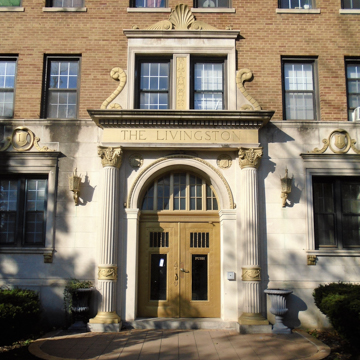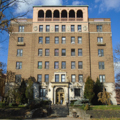After World War I Allentown expanded westward, with single and double houses built by the hundreds. At the same time, the mansions built at the turn of the twentieth century at the west end of Hamilton Street were joined by upscale apartment buildings. When built, the Livingston was the largest apartment building in eastern Pennsylvania outside Philadelphia. Its developer, Aaron Potruch, who had recently relocated to Allentown from Brooklyn, was also one of the backers of the Americus Hotel (LH3) just completed at the eastern end of Hamilton Street. The two buildings shared similar aspirations. A decade after its completion, a local newspaper declared the Livingston “the city's swankiest apartment.” Like the Americus, the Livingston had classical massing even as it displayed Spanish and Moorish motifs. Six stories in height, the building has a limestone ground floor, above which are five floors of buff-colored brick. A large rooftop terrace shaded by a round-arched loggia tops the slightly projecting center element of the facade. The Livingston remains one of the city's most highly regarded apartment buildings.
You are here
Livingston Apartments
If SAH Archipedia has been useful to you, please consider supporting it.
SAH Archipedia tells the story of the United States through its buildings, landscapes, and cities. This freely available resource empowers the public with authoritative knowledge that deepens their understanding and appreciation of the built environment. But the Society of Architectural Historians, which created SAH Archipedia with University of Virginia Press, needs your support to maintain the high-caliber research, writing, photography, cartography, editing, design, and programming that make SAH Archipedia a trusted online resource available to all who value the history of place, heritage tourism, and learning.







